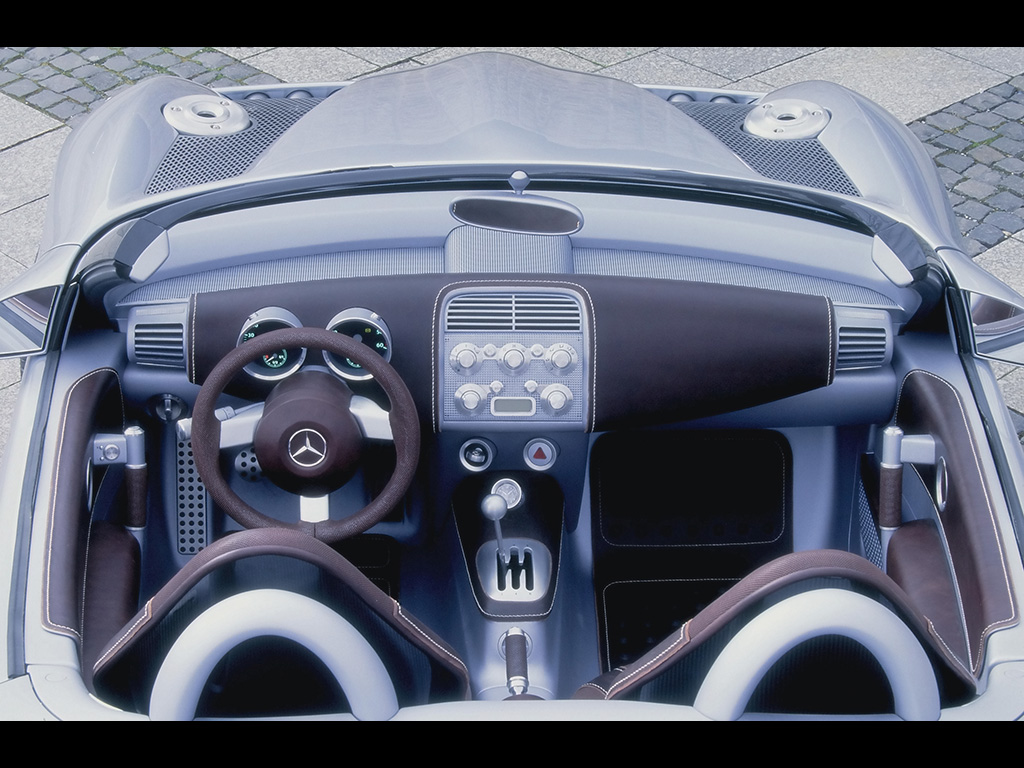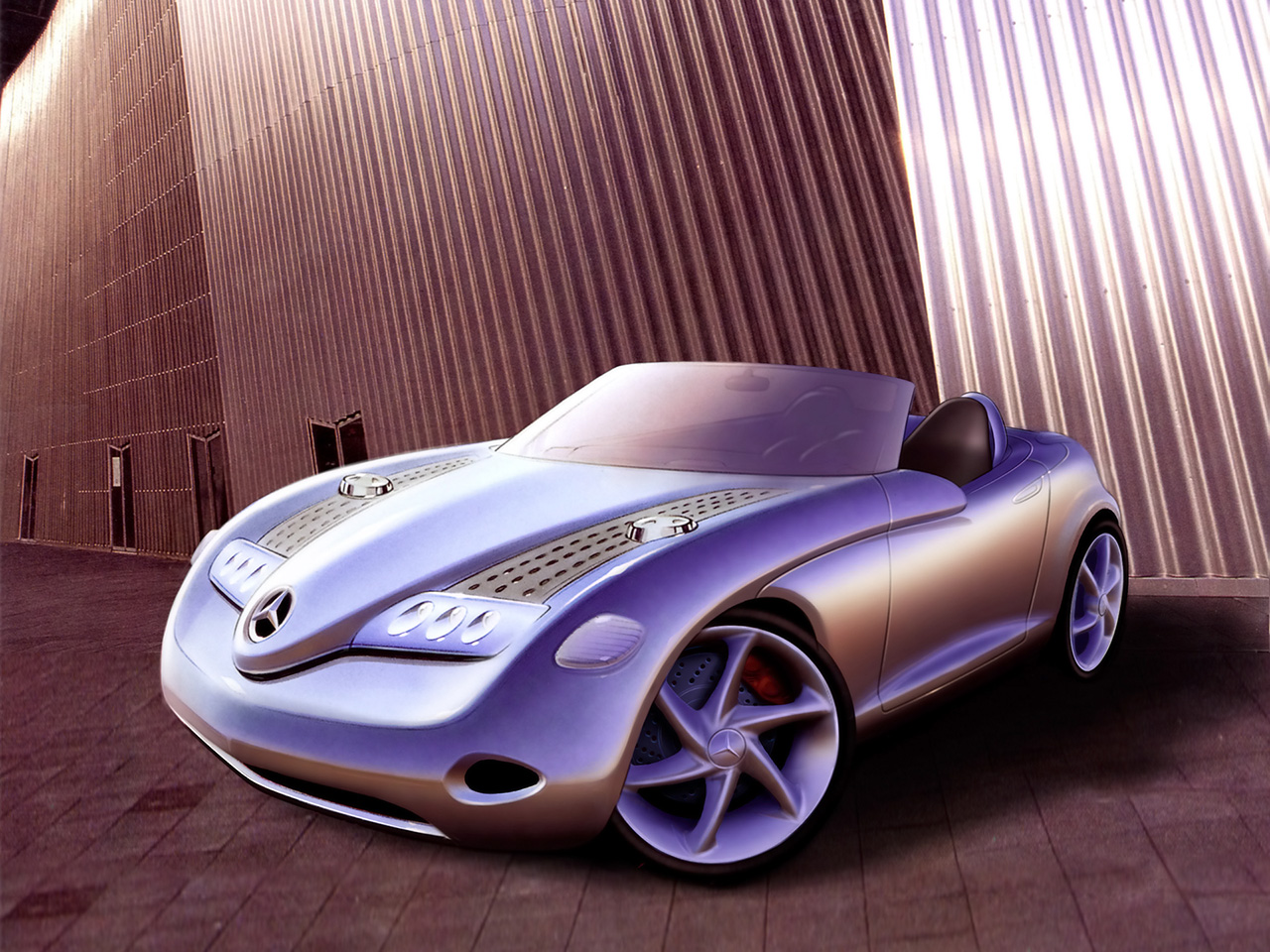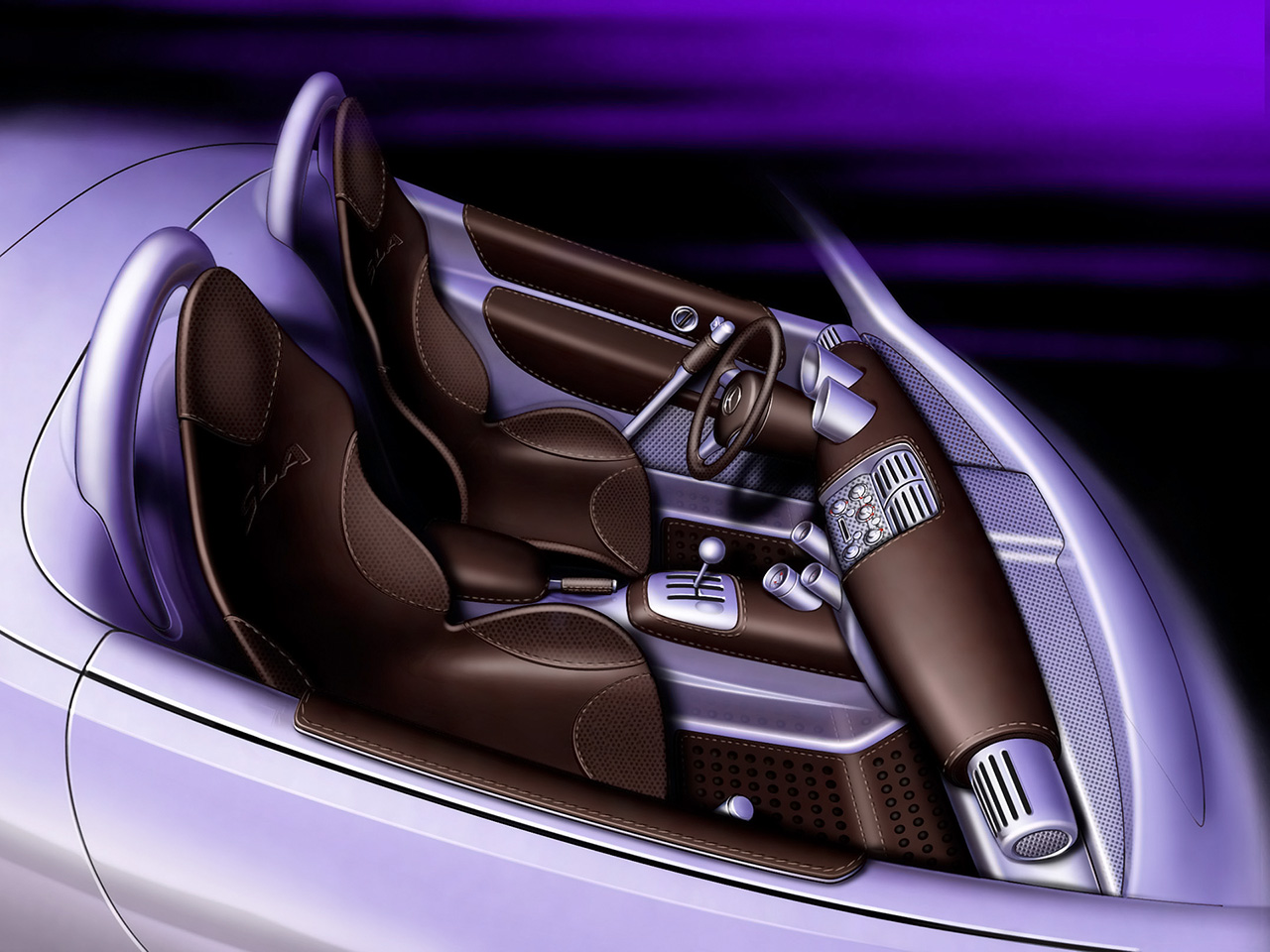2000 Mercedes-Benz Vision SLA Concept
|
Price |
-- |
Production |
-- | ||
|
Engine |
1.9 liter four-cylinder |
Weight |
2094 lbs | ||
|
Aspiration |
natural |
Torque |
133 lb-ft @ 4000 rpm | ||
|
HP |
125 hp |
HP/Weight |
16.8 lbs per hp | ||
|
HP/Liter |
65.8 hp per liter |
1/4 mile |
-- | ||
|
0-62 mph |
7.9 seconds |
Top Speed |
130 mph |
(from DaimlerChrysler
Press Release) Vehicle: Vision SLA
When: January 2000
Where: North American International Auto Show, Detroit
What: Compact roadster
Powertrain: Four-stroke, four-cylinder gasoline engine, 1.9
liter displacement, 92 kW (125 hp), front-wheel drive, five-speed
manual transmission
Technical highlights
Lightweight hybrid
bodywork consisting of aluminum sections and panels and high-grade
plastics
LED rear light clusters -> introduced 2003 in the Mercedes-Benz
SLR McLaren (C 199)
LED turn signals -> introduced 2003 in the Mercedes-Benz SLR
McLaren (C 199)
Carbon fiber bucket seats -> introduced 2003 in the
Mercedes-Benz SLR McLaren (C 199)
"Arousing curiosity …
firing the emotions … thinking ahead … anticipating the future and
translating new ideas into reality – the designers at the Mercedes
Technology Center in Sindelfingen certainly have an interesting job.
Their 'present' is the future. And sometimes they give us glimpses
of that future by bringing out concept cars – cars which show us how
we will be getting around in a number of years' time. The new Vision
SLA is one such glimpse."
This was how Mercedes introduced the Vision SLA when it made its
public debut at the Detroit Auto Show in January 2000. A small
roadster based on the A-Class, the Vision SLA's aim was to translate
the appeal and driving enjoyment of the SL series into an altogether
smaller segment.
Reflecting its A-Class parentage Vision SLA had compact dimensions,
with an exterior length of 3.77 meters promising a nippy driving
experience – the SLK (R 170) was 20 centimeters longer, the SL (R
230) no less than 73 centimeters longer. Key design features of the
compact roadster concept included powerfully sculpted fenders, a
sharply raked windshield, large doors and a gently slanting rear in
the style of the legendary Mercedes Silver Arrows. Two particularly
innovative features were a prominent front fin and a V-shaped nose
borrowed from the SLR high-performance sports car, which
incorporated a centrally positioned Mercedes star.
The bodywork sheltered advanced Mercedes engineering. A 1.9 liter
engine developing maximum power of 92 kW (125 hp) and maximum torque
of 180 Newton meters at 4000 rpm provided lively performance, with a
0 - 100 km/h sprint time of 7.9 seconds and a top speed of 209 km/h.
High active safety standards meanwhile were provided by the
A-Class-derived, slightly modified chassis with Electronic Stability
Program (ESP) and Brake Assist.
With the bodywork, the staff from the advanced engineering and
research departments had broken new ground. The Vision SLA had an
innovative hybrid body structure consisting of aluminum sections and
panels and high-grade plastics. This lightweight construction
allowed Vision SLA to tip the scales at just 950 kilograms (DIN
unladen weight).
The A-Class influence could be seen in the safety concept too.
Although the open-top two-seater wasn't built on the sandwich
principle, in the event of a serious front-end impact it used the
same bright idea as the A-Class of shunting the engine out of the
way underneath the passenger compartment. The positioning of the
engine at an angle ensured that in an impact it would slide down
along the sturdy front floor panel without intruding into the
passenger compartment. This gave Vision SLA the same high safety
standards as larger Mercedes sedans. Roll-over protection was
provided by sturdy roll-over bars behind the seats and by a
reinforced front windshield frame.
Once again, lighting was an important development focus. At the
rear, 30 high-performance LEDs, with prisms to disperse the light,
provided a more effective rear warning system than conventional
bulbs, particularly in conditions of poor visibility. It took the
form of vertical bands. The powerful LED turn signals, housed on
fins inside the light housings, were likewise innovative and
designed to attract attention. High-performance LEDs were also used
for the brake lights, which were mounted in the rear bumper and in
the rear crossbar on the trunk lid. Evenly dispersed road
illumination and a long beam range were provided by state-of-the-art
xenon projector-beam headlamps which used two separate headlamps for
the dipped beam and the high beam.
At the front, the transparent ends of a frontal fin spanning the
full width of the car incorporated yellow high-performance LED turn
signals, which were supplemented by repeater LEDs in the exterior
mirror casings.
Inside, the accent was on lightweight design. The technical aspects
were woven neatly together with styling features suggesting
lightness and transparency, such as perforated sheet metal, aluminum
rotary controls and aluminum instrument cylinders. Carbon fiber
bucket seats, adopted in slightly modified form from the Vision SLR,
continued the theme – they were approximately 25 percent lighter
than similarly specified conventional car seats.
The cockpit recalled sports cars and tourers of earlier years. The
chronometer-style instruments normally supplied data only on speed,
rpm, oil pressure and fuel level. However, other displays appeared
behind the dials when needed, in the event of a malfunction.
In all respects Vision SLA put the accent on a natural and
unfiltered motoring experience. This was at the heart of this
roadster's charm and was reflected in the interior design. Carpeting
and fabric upholstery had been dispensed with in favor of painted
metal surfaces and dark brown, specially supplied saddle-quality
leather. This leather was tanned using only vegetable matter, thus
helping to preserve its very special character. A natural material
with a strong air of quality, hard-wearing and also very breathable,
it was used on the dashboard, on the insides of the doors and in
areas exposed to frequent occupant contact, such as the steering
wheel, the seat surfaces, the armrests in the doors and the floor.
The cut edges were deliberately left visible, with light-colored
stitching providing a color contrast and hand-finished effect.
With Vision SLA, a compact Mercedes-Benz roadster made its debut.
The concept has been developed and refined to the point where it
would be ready to go into production at a moment's notice. Who
knows? Before long we might even see it in the showrooms.



